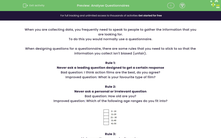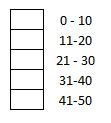When you are collecting data, you frequently need to speak to people to gather the information that you are looking for.
To do this you would normally use a questionnaire.
When designing questions for a questionnaire, there are some rules that you need to stick to so that the information you collect isn't biased (unfair).
Rule 1:
Never ask a leading question designed to get a certain response
Bad question: I think action films are the best, do you agree?
Improved question: What is your favourite type of film?
Rule 2:
Never ask a personal or irrelevant question
Bad question: How old are you?
Improved question: Which of the following age ranges do you fit into?
Rule 3:
Make sure the ranges don't overlap
Bad question: How many hours do you exercise a week?
0 - 1
1 - 2
2 - 4
Note that for this one, if you exercised for two hours, you wouldn't know which box to enter the data in.
Improved question:
How many hours do you exercise a week?
0 < x ≤ 1
1 < x ≤ 2
2 < x ≤ 3
Using the inequalities allows us to cover each option but not duplicate them.
Rule 4:
Cover all the options
Bad question: What colour is your hair? Red, black, brunette, blonde
Improved question: What colour is your hair? Red, black, brunette, blonde, none, other
The usual way you can deal with this is to put options for none or other (if they are appropriate).
Let's try some questions now.









